
Oh India. You can’t hide the skeletons in your closet forever.
It appears that the US Commission on International Religious Freedom was on its way to India this week. (The USCIRF is a federal group that works to promote freedom of thought, conscience and religion; protect people from abuses like detention, killing and torture; and challenge religious intolerance and repression throughout the world.) Well, they were scheduled to go, had their tickets ready and their bags packed. But India’s administration decided that they weren’t welcome in India.
It’s really quite ironic. The Congress party’s recent Parliamentary win over the BJP has been seen as an explicit rejection of the religious intolerance that the BJP represents (though it may have had more to do with support for Congress’ economic policies). Yet it is the Congress party administration that has refused USCIRF entry. Maybe the Congress party’s sound defeat of the BJP has swelled the Congress Party’s confidence a little too much.
New Delhi knew that the USCIRF team was scheduled to leave on June 12, but the visas just didn’t get stamped in time. Was it just a rare and regrettable oversight? [After all, with so many tourists flooding the country, a few visas could fall through the cracks right? (HA!)]
A recent article out of Surrey, Canada discusses an education and prevention video targeted at alcohol abuse in the Punjabi community. The video, titled Kharaab Daru-Bad Medicine, was created by Peace Arch Community Services – a social service agency based in British Columbia, Canada.
Kharaab Daru-Bad Medicine, which premiers this week in Delta, is hoped to become a resource in the prevention and reduction of alcohol misuse and abuse within the Punjabi community, said director Kevin Letourneau, PACS’ manager of addiction services.
The video is in Punjabi with English subtitles and aims to address the prevalence of alcohol abuse in our community.
In Bad Medicine well known Punjabi speaking professionals along with individuals impacted by alcohol, share their knowledge with respect to the harms and risks associated with problem drinking, mistaking alcohol as medicine, how alcohol impairs mental and physical functioning, drinking and driving, addiction and family violence, and the benefits of recovery.
The Director of Peace Arch Community Services (PACS) rightfully notes that alcohol abuse is one of those “closet things” in the Punjabi community and is often used as a way to cope with various societal pressures. The need for the video came about after group counseling at PACS which involved Punjabi men who were court-ordered to get help after committing crimes while under the influence. A similar video was launched by Drug and Alcohol Action Programme (an organization addressing these issues for our community in the UK) last year and addresses the issue of both alcohol and drug use. The video, which I have included after the jump, was also presented in Punjabi with English subtitles. I think it’s vital that this education continues to be provided using Punjabi to provide greater awareness and accessibility to the community. We need to wake up and start facing our problems and we need to start holding our community accountable.
I wanted to take the time to highlight two issues (Part 2 to be posted soon) which have plagued the Punjabi Sikh community for many, many years. I know that discussing these issues over and over again is overwhelmingly tedious for the majority of people. Quite frankly, I agree. However, if I didn’t believe that having these important discussions and bringing awareness to these issues over (and over, and over) again added some value to potential solutions – then I wouldn’t waste the space. Needless to say, these issues don’t seem to be going away which means these conversations are that much more important to have.
A recent article in the NYTimes expresses surprise at the fact that female feticide is occurring within immigrant communities residing in the United States. The thought seems to be that preference of male children should ideally disappear with assimilation into western societies. (For those of us hanging out in The Langar Hall, we know this isn’t always the case in the Punjabi community). The article uses US Census Data to provide quantitative evidence that there exists a bias for male children in certain Asian American communities.
Demographers say the statistical deviation among Asian-American families is significant, and they believe it reflects not only a preference for male children, but a growing tendency for these families to embrace sex-selection techniques, like in vitro fertilization and sperm sorting, or abortion.
New immigrants typically transplant some of their customs and culture to the United States – from tastes in food and child-rearing practices to their emphasis on education and the elevated social and economic status of males. [emphasis added]
This latter point is especially significant. Is the problem of sex-selective abortions purely cultural and is that why it continues to be an “acceptable” problem?
 Just before the weekend, NPR featured a story on Akal Securities and the Sikh community in New Mexico. The article discusses the success of a number of businesses that help support the 3HO organization. It is partly due to these generous contributions by community members and leaders of these businesses that as a community we benefit from the inspiring resources such as Sikhnet.com. As an attendee at the annual Los Angeles Vaisakhi Nagar Kirtan, I have witnessed the beautiful display of the Sikh community, largely led by members of the 3HO, year after year.
Just before the weekend, NPR featured a story on Akal Securities and the Sikh community in New Mexico. The article discusses the success of a number of businesses that help support the 3HO organization. It is partly due to these generous contributions by community members and leaders of these businesses that as a community we benefit from the inspiring resources such as Sikhnet.com. As an attendee at the annual Los Angeles Vaisakhi Nagar Kirtan, I have witnessed the beautiful display of the Sikh community, largely led by members of the 3HO, year after year.
For those familiar with Akal Securities, you can find their ubiquitous khanda symbol everywhere. From airports, to security guards in front of Target, I have had a sense of pride whenever I see their logo. It is a tremendous example of our Sikh brethren being successful and specifically an example of individuals that use their success to contribute to the Sikh community in general. This is not to say that the company has not had its share of problems (and successes), but still I believe it is a model and a successful one and deserves recognition.
 Many eons ago, my friend Mewa Singh wrote:
Many eons ago, my friend Mewa Singh wrote:
Most Sikh organizations’ backbone tend to be its Kaurs.[link]
[As a side note, kaptaan, where did you go?] I definitely second that thought. A common lament that I often hear from some Sikh men is that somehow Sikh women are somehow lacking in terms of their commitment to the faith. I do not subscribe to this theory, and would actually refute it by Mewa Singh’s observation quoted above. By far the majority of the activists that I have ever encountered have all been Kaurs, despite the often blind Sikh organizations. The banal complaints of some Sikh men, for me, are just that – banal complaints.
Still, as an agent of change within the community, I believe a glance at the structural problems within our religious community is warranted. A recent spate of articles has made me wish to visit the issue of female Granthis
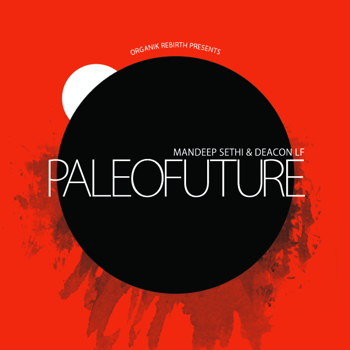 I know I have been posting about it much lately, but as full disclosure compels, I have helped with the organization in the past. A few weeks ago I posted about this weekend When Lions Roar in Toronto and Vancouver. It seems in the wake we have something in the making in Central California, Fresno. For regular readers of The Langar Hall, you’ve been introduced to the talents and music of Sikh Knowledge, Humble the Poet, GNE’s Saint Soulja, and even Mandeep Sethi. As a side note, Mandeep has the most amazing track I have ever heard by a hip-hop artist on 1984. Make sure to check it out.
I know I have been posting about it much lately, but as full disclosure compels, I have helped with the organization in the past. A few weeks ago I posted about this weekend When Lions Roar in Toronto and Vancouver. It seems in the wake we have something in the making in Central California, Fresno. For regular readers of The Langar Hall, you’ve been introduced to the talents and music of Sikh Knowledge, Humble the Poet, GNE’s Saint Soulja, and even Mandeep Sethi. As a side note, Mandeep has the most amazing track I have ever heard by a hip-hop artist on 1984. Make sure to check it out.
This month they will all be attending, participating, and performing at the Jakara Movement’s annual conference. With few seats left and this major addition, you will not want to miss this year’s conference as we come together to “Remember 1984.” The dates are June 18-21, 2009. Register TODAY to avoid a late fee. See you in Fresno.
This week I came across a couple of interesting stories out of the UK about how 1984 has since affected Sikhs. BBC Asian Network is currently previewing a radio documentary, hosted by Pops from Tigerstyle, discussing the impact Operation Bluestar has had on British Sikhs. The documentary discusses what impact, if any, 1984 has had on the Sikh conscience and the political activism that emerged. During that year, weekly covers of Des Pardes portrayed pictures of dead Sikhs – images that have stayed with many of us over the years. There existed a sense of hopelessness many Sikhs felt after only reading about and hearing of what was happening in Punjab. As one young Sikh woman states, “a record number of people took Amrit in that year”.
Before 1984 there were fears within the British Sikh community that young Sikhs, in particular, were assimilating into British way of life. A the time what Bluestar did was galvanize the community. .. and generally Sikhs were put on the spot by Operation Bluestar globally and in 1984, in the immediate aftermath, there was a great reassertion of Sikh identity – the visual representation of Sikh identity.
In a Guardian article yesterday, Sunny Hundal discusses how Operation Bluestar and the subsequent events have impacted Sikhs since.
Almost every year groups gather in London to commemorate these events and raise awareness of people still missing or locked up. Sometimes, the Indian flag is torched. In one report produced for the anniversary, the whole episode it is described as the “Sikhs’ Kristallnacht”. But while these facts are well documented and constantly discussed, there is less acknowledgement of how the episode has affected Sikhs since. [link]
He goes on to highlight three ways 1984 is still impacting Sikhs,
Over at Huffington Post, a lovely reflection on “The Cancer of Religious Narcissism” appeared recently. It’s point of orientation was the violence amongst Austrian Sikhs. The focus however, was on how religious narcissism is often the cause of such religious violence- when the slightest doctrinal difference leads to bloodshed… not only amongst Sikhs, but also amongst other faith communities. For example, in 2008, Greek and Armenian priests and worshippers exchanged blows at one of Christianity’s holiest shrines.
Catholics all over Europe have killed Protestants by the thousands and slaughtered their children, and Protestants have done the same. The Crusaders mounted genocidal attacks on Arabs and Jews. Modern efforts to win over moderates in Afghanistan are consistently sabotaged by fundamentalist military chaplains who tell our troops they’re fighting Satan and should be murdering anyone they can’t convert.
Precisely what the Imams are telling the Taliban. For homicidal proclivities seem endemic to most of the world’s major religions. Hindus and Muslims slaughter each other, as do Israelis and Palestinians, Sunnis and Shiites. And the Bible is filled with genocide, supposedly ordered by God. Why is this so?
The author’s’ answer: most organized religions are based on systems of belief. And we all want to believe our own tales are fact.
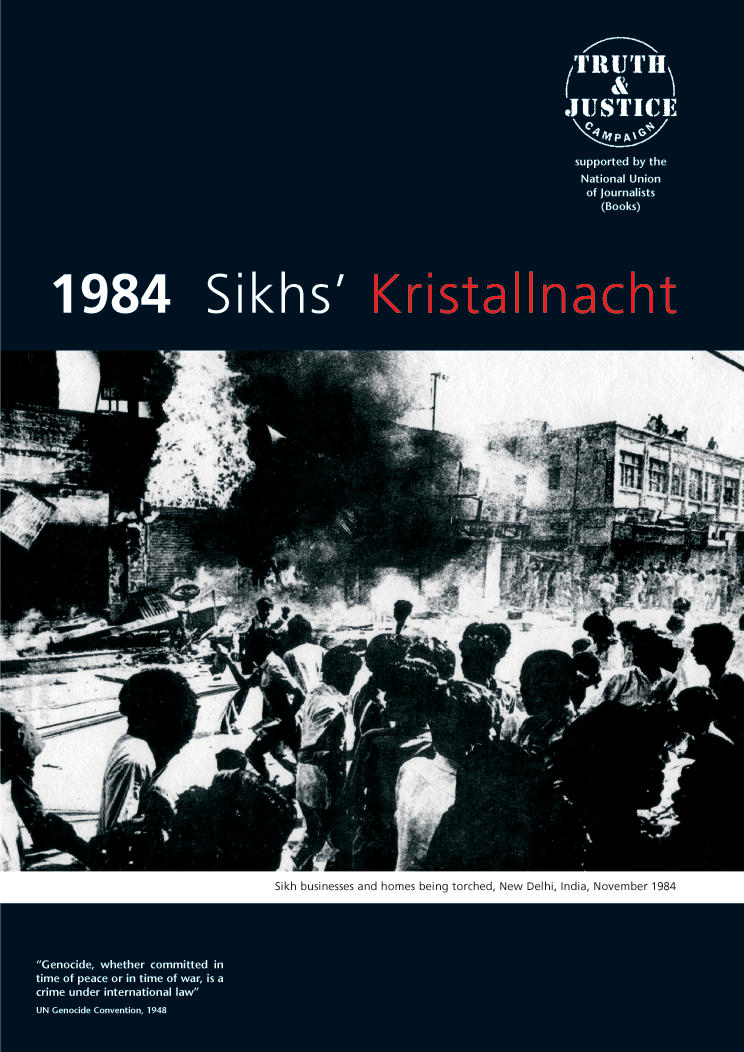 As we like to keep our readers updated, I wanted to let you know about some current events that you shouldn’t miss as well as some programs and resources that you can do with your own family and friends in your hometown.
As we like to keep our readers updated, I wanted to let you know about some current events that you shouldn’t miss as well as some programs and resources that you can do with your own family and friends in your hometown.
- The Jakara Movement conference: “Remember 1984: Reflect. Respond. React.” With limited days remaining, register BEFORE THURSDAY (June 4th, 2009) to avoid the late fee. I have written about it in the past. You won’t want to miss it.
- Last week, I wrote about the “Sukhmani Sahib for the Shaheeds” project. You can participate in your hometown by arranging a Sukhmani Sahib this weekend. Be part of a national group and download the packet from here. The packet contains, instructions, other upcoming events, and a special Benti to be read during the Ardas. Even if you can’t make it to Fresno for the conference, honor the memory of our Shaheeds through Sukhmani Sahib.
- Finally Sikh organizations have come together to off for free the Sikhs’ Kristallnacht booklet to educate Sikhs and non-Sikhs alike:
Mark your calendars- the Kaur Foundation and the Asian Division of the Library of Congress have 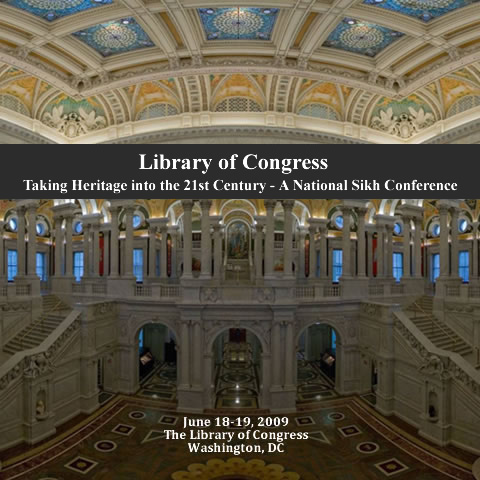 teamed up to undertake a unique initiative, to institutionalize knowledge by and about the Sikh community for future generations. The Library of Congress is the oldest federal cultural institution in the US, the largest library in the world, and the research wing of Congress. (LOC). The Sikh Collection Initiative is an effort to ensure that knowledge of and by Sikhs is collected and preserved for future generations. Given the tragic loss of valuable cultural and religious artifacts, manuscripts, and books from the Sikh Reference Library in the Darbar Sahib complex during Operation Bluestar, an initiative such as this begins to ensure that collective knowledge of our community will be preserved somewhere.
teamed up to undertake a unique initiative, to institutionalize knowledge by and about the Sikh community for future generations. The Library of Congress is the oldest federal cultural institution in the US, the largest library in the world, and the research wing of Congress. (LOC). The Sikh Collection Initiative is an effort to ensure that knowledge of and by Sikhs is collected and preserved for future generations. Given the tragic loss of valuable cultural and religious artifacts, manuscripts, and books from the Sikh Reference Library in the Darbar Sahib complex during Operation Bluestar, an initiative such as this begins to ensure that collective knowledge of our community will be preserved somewhere.
As our nation grows and becomes more diverse, it is critical that we appreciate and understand the different backgrounds of all that make this country great. Sikh Americans have significantly contributed to every field of human endeavor from technology, commerce, health, science, agriculture, to the arts – further enriching the cultural fabric of this land of immigrants.
Guest Blogged by Mewa Singh
No, I didn’t actually grow up with Inderjit Bains, but by the end of the post, you’ll get it.
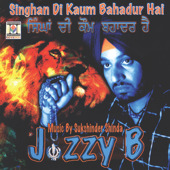 For those that have been following the North American bhangra scene, since its inception (remember, DJ Sunshine, DJ Guru, – I never liked DJ Jiten’s Hindi remixes – and, yes, even DJ Russell Peters), then the name Inderjit Bains needs no introduction.
For those that have been following the North American bhangra scene, since its inception (remember, DJ Sunshine, DJ Guru, – I never liked DJ Jiten’s Hindi remixes – and, yes, even DJ Russell Peters), then the name Inderjit Bains needs no introduction.
In North America, bhangra started with remix DJs in Toronto, but it took Inderjit Singh Bains to help change the scene. It was he, as a pioneer, that helped launch North America’s first true bhangra star – Jazzy B (although at the time, few of us would ever admit to it and spent most of our days hating on Jazzy’s various haircuts on bootleg tape covers).
The trajectory of North American bhangra, influenced in the early 1990s with the explosion of Westcoast gangster rap and especially G-funk, reshaped the global bhangra scene. While UK artists like Apache Indian and Bally Sagoo were doing their own type of hybridity with reggae and bhangra, Inderjit Bains was successful in bridging a ‘folk sound’ with hip-hop influenced bhangra beats. He found a formula. After the success of Jazzy B, he helped launch the career of Central California’s Bhinda Jatt (Bhinda took the early 90s gangster image, much further than Jazzy did, during that time), Madan Maddi and even Sukhshinder Shinda.
My fellow langa(w)r-iter wrote about his latest project – working with a kindred social activist spirit in the artist Taranampreet on her song “Teri Meri Bas: Sat Sri Akal”. While the focus on that post was on the role play women play men’s upkeep of the Sikh appearance (will we ever get a song on the role men play on the women’s upkeep of the Sikh appearance?), I want to take a bit of a different angle.
This week, Peter Bance published “Sovereign, Squire and Rebel: Maharajah Duleep Singh and the Heirs of a Lost Kingdom.” It includes some little known and interesting information on Rani Jindan- the youngest of Maharaja 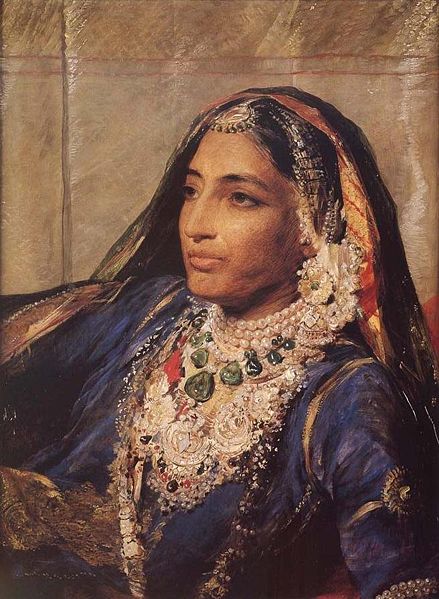 Ranjit Singh’s wives. While the tale of her son, Duleep Singh, has been well documented, less has been known about Rani Jindan.
Ranjit Singh’s wives. While the tale of her son, Duleep Singh, has been well documented, less has been known about Rani Jindan.
While researching a tome on the Duleep Singh family, which lived in exile on a sprawling country estate near Thetford, Norfolk, Mr Bance stumbled upon the gravestone of Jind Kaur in the catacombs of the Kensal Green Dissenters’ Chapel. Historians had assumed that the Maharani’s cremation occurred in India but here was a simple white marble tombstone in London with her name on it. [link]
So who was Rani Jind Kaur? Some things were previously known- that after the death of her husband, she became the Regent (acting head of state because the ruler is a minor) for her son, Duleep Singh.
To say that Jind Kaur was a thorn in the side of the East India Company would be an understatement. She was born into humble origins, the daughter of the Royal Kennel Keeper at the Sikh court in Lahore, but she was ravishingly beautiful and soon caught the attention of the Punjab’s greatest ruler, the one-eyed Ranjit Singh.
Having kept the British at bay for decades, Ranjit’s empire began to crumble with his death in 1839. Following a series of bloody succession battles, Jind emerged as regent for Duleep who was less than a year old when his father died. [link]
Rani Jindan was instrumental in organizing Sikh resistance to the British in the First and Second Anglo-Sikh wars.
 Last year we discussed Satnam Sanghera’s memoir, If You Don’t Know Me By Now: A Memoir of Love, Secrets and Lies in Wolverhamptom, and dialogued around the issue of mental health in the Punjabi Sikh community. The memoir was recently awarded the Mind Book of the Year Award for its literary contributions to raising awareness around issues of mental distress. The Boy with the Topknot, as it is now known, was picked from 110 entries by Mind, a non-profit organization in the UK committed to creating a “better life for everyone with experience of mental distress”.
Last year we discussed Satnam Sanghera’s memoir, If You Don’t Know Me By Now: A Memoir of Love, Secrets and Lies in Wolverhamptom, and dialogued around the issue of mental health in the Punjabi Sikh community. The memoir was recently awarded the Mind Book of the Year Award for its literary contributions to raising awareness around issues of mental distress. The Boy with the Topknot, as it is now known, was picked from 110 entries by Mind, a non-profit organization in the UK committed to creating a “better life for everyone with experience of mental distress”.
On winning the award last night, Sathnam Sanghera said:”It was such a strong shortlist, and this award is judged by some of the greatest authors in the UK, so this is a real privilege. There are hardly any books about Asian communities’ experiences of mental health problems, so I hope people read this book and it leads to more understanding.” [link]
I would highly recommend this book as I found the story to be sincere and enlightening. However, I would add that while it is important to provide this type of insight to the English-speaking literary community, it is just as (or perhaps even more so) important to ensure this type of literature is accessible to the Punjabi-speaking community. Perhaps we can strive to have these types of memoirs translated into Punjabi or made available via audiorecordings?
He locked the washroom door, unravelled the nine-metre turban, took a pair of scissors and started cutting. Ten minutes later, three feet of hair lay in a pile and Charanbir Singh sat down and cried.
Outside, his parents and grandmother were in tears. Two friends persuaded him to come out, but Charanbir, his head wrapped in a towel, rushed to his room.
That was a year ago. Charanbir, now 17, still shudders at the memory. “I had to cut my hair.” (Link)
One of ironies of life in the 21st century western world is that despite an unparalleled degree of freedom of religion, the majority of people seem to be opting for freedom from religion.
Last week, Raveena Aulakh, a reporter from the Toronto Star, put a Canadian twist on the worldwide issue of apostasy amongst Sikh Youth.
Sikhism dates back to 15th-century India. Adherents are required to not cut their hair, considered a visible testament to their connection with their creator. The turban was adopted to manage long hair and make Sikhs easily identifiable.
For many young men in Greater Toronto, that is the problem: They don’t want to stand out.
Like other new or second-generation immigrants, many Sikh youngsters are desperate to fit in with the school crowd, while others complain of racism because they wear the turban. Add to that cultural influences, peer pressure and the desire to assimilate.
The end result? Many youngsters cut their hair, leading to family friction and, in some cases, lasting estrangement.
As a counterpoint, in the article and video above, Pardeep Singh Nagra (of boxing fame) presents his thoughts on why he’s decided to keep his hair.
Fear & Guilt
I’ve often wondered why so many Sikh youth keep their hair through high school but cut it as soon as they feel free from their parent’s control? From my perspective I see this as symptomatic of a great challenge facing Sikhs around the world today. Somehow, someway, we have fallen into the trap of pushing Sikhi to the next generation with fear and guilt, rather than sharing Sikhi through love.
Take your typical Sikh family; actually take mine. My now 25 year old cousin in Punjab had wanted to cut his hair since he was a teenager but two things stopped him. He was afraid that if he cut his hair his dad would beat him and then disown him. Secondly, he knew that if he did get a haircut and shave he wouldn’t be able to look his crying mom in the eye.
Unfortunately, there was little positive reinforcement around Sikhi in his life. Sure there was Sikhi by osmosis: visiting Gurdwaras, gurbani playing in the background, the odd sakhi told by our visiting grandfather. However, my cousin had little exposure to the aspects of Sikhi (nitnem, kirtan, seva, simran) that would have connected him with his faith on a deeper level. Most of the discussions with his parents were a flavour of the famous Goodness Gracious Me clip. So not surprisingly, upon entering college, he too cut his hair. And sure enough, he became our family’s black sheep, making a kid with already low self-esteem, feel even worse.
June soon approaches and many in the Sikh community will take the time to remember the events beginning in 1984. While some traditional sites of remembrance, mainly Gurdwaras, will continue to fulfill their duties to celebrate those that gave their lives and remember those families devastated by the Indian state’s violence, especially encouraging are new Sikh youth initiatives. Last week I discussed the Jakara Movement Sikh Conference and even the initiative “Sukhmani Sahib for the Shaheeds.” Now in Canada, the Sikh Activists Network is hosting two tremendous events.
The Details:
When Lions Roar: A Night of Music, Poetry, and Performance
Remembering the Sikh Genocide of 1984Toronto: Friday June 5th, Crown Banquet Hall (Malton), 6pm
Vancouver: Friday July 3rd, Rhizome Café (Vancouver), 6pmAdmission is FREE, but give a donation so that they can continue this initiative

My last post was about what we knew at that time. Since then, there are new updates.
After the attack in the Vienna temple (actually a dera of the Sach Khand group), there are news confirmations that Sant Rama Nand has passed away from his injuries, while the Dera head Niranjan Das is in stable condition.
There are also reports of violence in Punjab. IBN live reports the death of 2 people in the Doaba region and also one should note that it seems that the army has been called in to parts of Punjab.
One person was killed and four others were injured as Army jawans opened fire in Lambra village, 30 kms from Jalandhar. Another person was killed after the police opened fire on protesters at Jalandhar Cantonment railway station. [link]
In some ways I believe that this is a tragedy of the 80s and 90s.
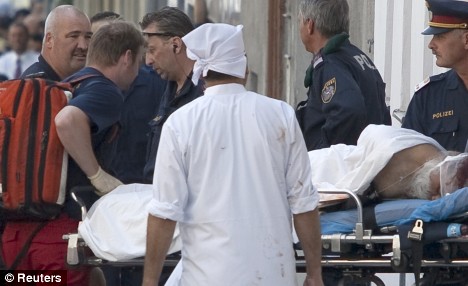 As suggested by our readers (pagh salute: ambi and an indian Sikh), I am posting on the tragedy in Vienna. The facts are still coming in, so we have little perspective on what exactly occurred.
As suggested by our readers (pagh salute: ambi and an indian Sikh), I am posting on the tragedy in Vienna. The facts are still coming in, so we have little perspective on what exactly occurred.
This much is known. In the Austrian capital of Vienna, six Sikh men carrying various weapons and a handgun entered a Dera [Some media are calling this a ‘Sikh temple’ or a ‘gurdwara’, but it seems to be a dera attached to the Sach Khand group]. The men proceeded to go towards the ‘preachers’ of the Dera and in the melee 16 people have been reported injured, including 6 seriously – two names have been reported amongst the injured – Niranjan Das and Sant Rama Nand – and the other 4 were the attackers (there are rumors that Sant Rama Nand may have been killed, but this has not yet been confirmed. Sant Rama Nand is one of the highest leaders of the SachaKhand Dera).
Some of the media is attempting to frame the dispute in terms of caste, asserting that the Dera is set up to honor Bhagat Ravi Das, whose own Bani can be found in the Guru Granth Sahib. Other reports for a cause have provided the following:
[the attackers] accused one or both of the preachers of being disrespectful of the Holy Book [Sri Guru Granth Sahib]. Indian news reports said the attackers were incensed that one of the preachers was given a ceremonial shawl considered a high Sikh honor. [link]
Still some of the local press has provided the following reason:
It was assumed by local media that the conflict between the temples like competing for worshipers might be the reason of this shooting incident. [link]
The story does not end there.
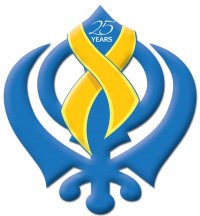 In The Langar Hall, we do our best to keep you up-to-date with the latest 1984 events. From conferences, to concerts, if it’s happening, we’ll post it.
In The Langar Hall, we do our best to keep you up-to-date with the latest 1984 events. From conferences, to concerts, if it’s happening, we’ll post it.
With the 25th commemoration of the Ghallughara, a great initiative called ‘Sukhmani Sahibs for the Sikh Shaheeds‘ (being held the first week of June, 2009) is being coordinated by the Jakara Movement throughout the United States. Starting in California, facebook groups have sprung up in Michigan, and the numbers of people participating are increasing. Texas and Washington DC have added to the list.
From their Facebook page:
The simplest, yet most powerful, thing one can offer another soul is a prayer.
Many of our parents are involved in Sukhmani Sahib groups in their local Gurdwaras. The Sikh Memorial Center is asking these groups, as well as any others that wish to participate, to come together and remember Guru Arjun’s Shahadat and the Memory of the Shaheeds that gave their lives in the third Ghallughara (June 1984). How to we propose this remembrance? We are asking for these groups across the North America to perform Sukhmani Sahib during the first week of June and open the event to their entire local Sangat.
So how can you help? Well if your parents or someone that you know participates within a Sukhmani Sahib group, help us get them on board with this project! This event is not exclusive to parents, if you or your friends would like to put together a Sukhmani Sahib group of your own, contact me.
The coordinators’ task is difficult. For many of us, our mothers are part of these groups and the organizers are calling males at Gurdwaras to get in touch with these groups. If your mother is part of such a group, help the coordinators leap frog the males and send an email to them. At least help out that much. Better is to join your mother in the Sukhmani Sahib. Best of all, start your own group! Get in touch to get the information packet mailed out to you.
AND, if you live near Fremont Gurdwara:
Thematically Sikh paintings are rare. Thus, when I came across the paintings below, I thought I should share. The oil paintings below are the work of Jaswant Singh Zafar. He’s a poet, photographer, and painter in his free time and an engineer in Ludhiana by day. This year, he’s spending his free time creating a series of paintings under the theme of ‘Gurbani.’ The paintings completed thus far weave the mool mantar through various aspects of nature, shapes, and other backgrounds.
At the end of the year, the series will be in an exhibition at the Artmosphere Gallery in Ludhiana. Artmosphere was created to provide a platform for budding artists in Ludhiana and Punjab such as Jaswant Singh Zafar. Such an endeavor cheers me and gives hope that the visual arts scene there is growing.

I appreciate these paintings because they provide some insight into the art scene in Punjab- an example of what’s happening there. More works from this series can be found here.
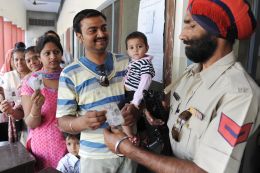 The election results in India seem to be in. The Congress Party has increased its power in the center and even some of the commenters here in The Langar Hall have been jubilant.
The election results in India seem to be in. The Congress Party has increased its power in the center and even some of the commenters here in The Langar Hall have been jubilant.
While the Indian elections have received brief commentary, here and there in The Langar Hall, the results call out for some analysis towards a Sikh perspective.
Overwhelming have been the shouts of “Singh is King” as it seems that Manmohan Singh will continue to keep the Prime Minister position, at least if his victory-speech is any indication, until his political overseers – the Gandhi family – are ready to replace the kursi-warmer with Rahul Gandhi. Others in The Langar Hall have already written critical pieces of this so-called Great Sikh Hype.
News media have rightly commented on the Congress Party’s sweeping electoral victories in Delhi on the party’s dumping of the mass-murderers Jagdish Tytler and Sajjan Kumar (albeit it seems more political maneuvering – with one of the positions filled by Sajjan Kumar’s brother, than any true remorse) and the projection of Manmohan Singh as a way to draw Sikh votes in Delhi away from BJP candidates. As a strategic community, Sikhs in no way should they tether their votes to a single party.
